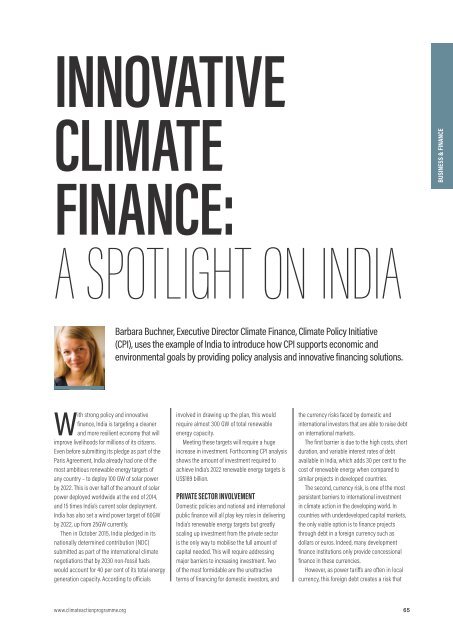Climate Action 2016-2017
Create successful ePaper yourself
Turn your PDF publications into a flip-book with our unique Google optimized e-Paper software.
INNOVATIVE<br />
CLIMATE<br />
FINANCE:<br />
BUSINESS & FINANCE<br />
A SPOTLIGHT ON INDIA<br />
Barbara Buchner, Executive Director <strong>Climate</strong> Finance, <strong>Climate</strong> Policy Initiative<br />
(CPI), uses the example of India to introduce how CPI supports economic and<br />
environmental goals by providing policy analysis and innovative financing solutions.<br />
With strong policy and innovative<br />
finance, India is targeting a cleaner<br />
and more resilient economy that will<br />
improve livelihoods for millions of its citizens.<br />
Even before submitting its pledge as part of the<br />
Paris Agreement, India already had one of the<br />
most ambitious renewable energy targets of<br />
any country – to deploy 100 GW of solar power<br />
by 2022. This is over half of the amount of solar<br />
power deployed worldwide at the end of 2014,<br />
and 15 times India’s current solar deployment.<br />
India has also set a wind power target of 60GW<br />
by 2022, up from 25GW currently.<br />
Then in October 2015, India pledged in its<br />
nationally determined contribution (NDC)<br />
submitted as part of the international climate<br />
negotiations that by 2030 non-fossil fuels<br />
would account for 40 per cent of its total energy<br />
generation capacity. According to officials<br />
involved in drawing up the plan, this would<br />
require almost 300 GW of total renewable<br />
energy capacity.<br />
Meeting these targets will require a huge<br />
increase in investment. Forthcoming CPI analysis<br />
shows the amount of investment required to<br />
achieve India’s 2022 renewable energy targets is<br />
US$189 billion.<br />
PRIVATE SECTOR INVOLVEMENT<br />
Domestic policies and national and international<br />
public finance will all play key roles in delivering<br />
India’s renewable energy targets but greatly<br />
scaling up investment from the private sector<br />
is the only way to mobilise the full amount of<br />
capital needed. This will require addressing<br />
major barriers to increasing investment. Two<br />
of the most formidable are the unattractive<br />
terms of financing for domestic investors, and<br />
the currency risks faced by domestic and<br />
international investors that are able to raise debt<br />
on international markets.<br />
The first barrier is due to the high costs, short<br />
duration, and variable interest rates of debt<br />
available in India, which adds 30 per cent to the<br />
cost of renewable energy when compared to<br />
similar projects in developed countries.<br />
The second, currency risk, is one of the most<br />
persistent barriers to international investment<br />
in climate action in the developing world. In<br />
countries with underdeveloped capital markets,<br />
the only viable option is to finance projects<br />
through debt in a foreign currency such as<br />
dollars or euros. Indeed, many development<br />
finance institutions only provide concessional<br />
finance in these currencies.<br />
However, as power tariffs are often in local<br />
currency, this foreign debt creates a risk that<br />
www.climateactionprogramme.org 65












